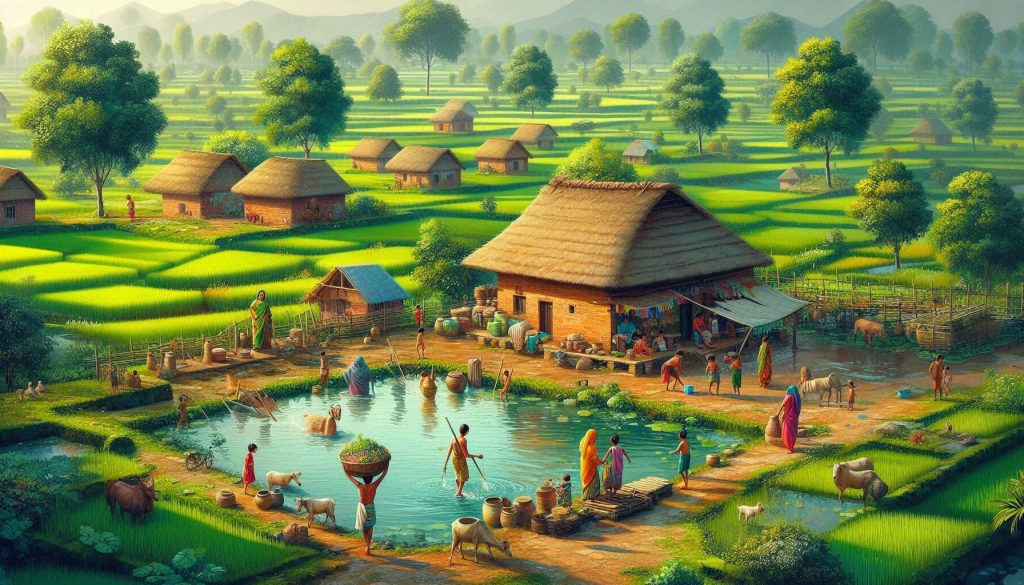The Story of Village Palampur – Complete Guide For Class 9 Economics Chapter 1

Welcome to iPrep, your Learning Super App. Our learning resources for the chapter, “The Story of Village Palampur” in Economics for Class 9th are designed to ensure that you grasp this concept with clarity and perfection. Whether you’re studying for an upcoming exam or strengthening your concepts, our engaging animated videos, practice questions and notes offer you the best of integrated learning with interesting explanations and examples.
This chapter “The Story of Village Palampur” delves into the economic activities and challenges faced by the village of Palampur. It explores the significance of land, labor, and capital in agricultural production, as well as the role of non-farm activities in the village’s economy.
The story of Village Palampur provides insights into the diverse economic activities and challenges faced by rural communities in India. This chapter will examine the factors of production, land distribution, labor availability, and capital requirements in Palampur’s agricultural sector. Additionally, it will explore the growing importance of non-farm activities, such as dairy, manufacturing, retail, and transport, in the village’s economy.
Objectives Of Learning The Story of Village Palampur
Now that we have analyzed the significance of the chapter, let us know the objectives of studying ‘The Story of Village Palampur’.
- Understand the concept of factors of production
- Analyze the role of land, labor, and capital in agricultural production
- Explore the challenges faced by farmers in Palampur
- Examine the importance of non-farm activities in the village’s economy
- Appreciate the diversity of economic activities in rural areas
Overview
Palampur is a small, vibrant village that serves as a microcosm of rural life in India. With its lush fields and hardworking community, Palampur offers a glimpse into the complex interplay between agriculture and other economic activities. The village is not only home to traditional farming practices but also to a variety of non-farm activities that contribute to its economy, making it a dynamic and self-sustaining community.

Now let’s explore the various sections of the chapter.
In the first place, to understand the economic activities in Palampur, let’s discuss the section Organization of Production.
Organization of Production
The major factors of production are listed below
- Land:
The most important resource for agricultural production.
- Labor:
Human effort is required for farming activities.
- Physical capital:
Machinery, tools, and equipment used in production.
- Fixed capital:
Long-term assets, such as tractors and buildings.
- Working capital:
Short-term assets, such as seeds and fertilizers.

Now, to discuss the agricultural practices and challenges faced by farmers, let’s delve into the section “Farming in Palampur” of the chapter “The Story of Village Palampur.”
Farming in Palampur
- Land is fixed:
The amount of land available for cultivation is limited.
- Increasing productivity:
Farmers use various techniques to grow more from the same land, such as using improved seeds and fertilizers.
- Sustainability:
The long-term sustainability of farming practices is a concern.
- Land distribution:
Land ownership in Palampur is unequal, with some farmers owning more land than others.
- Labor availability:
Farming is labor-intensive, and there is a need for an adequate labor supply.
- Capital requirements:
Modern farming practices require significant capital investment.
- Sale of surplus:
Farmers sell their surplus produce in local markets or to middlemen.

Now, to discuss the various economic activities beyond agriculture, let’s delve into the section “Non-Farm Activities in Palampur” of the chapter “The Story of Village Palampur.”
Non-Farm Activities in Palampur
- Dairy:
A common non-farm activity, providing a source of income for many households.
- Small-scale manufacturing:
An example is the production of handicrafts and other products.
- Retail:
Shopkeepers play a vital role in the local economy, providing essential goods and services.
- Transport:
A growing sector, with increasing demand for transportation services.

Finally, as we have gained comprehensive knowledge about the chapter The Story of Village Palampur, let’s reflect on the overall learning value of this important lesson.
Overall Learning Value of the Chapter
The story of Village Palampur highlights the diverse economic activities and challenges faced by rural communities. While agriculture remains the primary occupation, non-farm activities are playing an increasingly important role in the village’s economy. Understanding the factors of production, land distribution, labor availability, and capital requirements is essential for analyzing the economic dynamics of Palampur and similar rural areas.
Let’s Conclude
The chapter “The Story of Village Palampur” in Class 9th Economics provides a fascinating look into the economic framework of rural India, using Palampur as a model village. Through this chapter, students gain valuable insights into how agriculture, combined with non-farm activities, sustains rural life. The Story of Village Palampur also sheds light on the complexities of factors like land, labor, and capital, essential for production and growth in rural economies.
As you review this chapter in Economics for Class 9th, remember that these concepts form the foundation for understanding broader economic principles. With iPrep’s engaging learning resources for “The Story of Village Palampur,” students can master these concepts and develop a strong understanding of rural economic life. Keep exploring this crucial chapter to grasp how villages like Palampur contribute significantly to the nation’s economy.
Practice questions on Chapter 1 - The Story of Village Palampur
Get your free Chapter 1 - The Story of Village Palampur practice quiz of 20+ questions & detailed solutions
Practice Now








